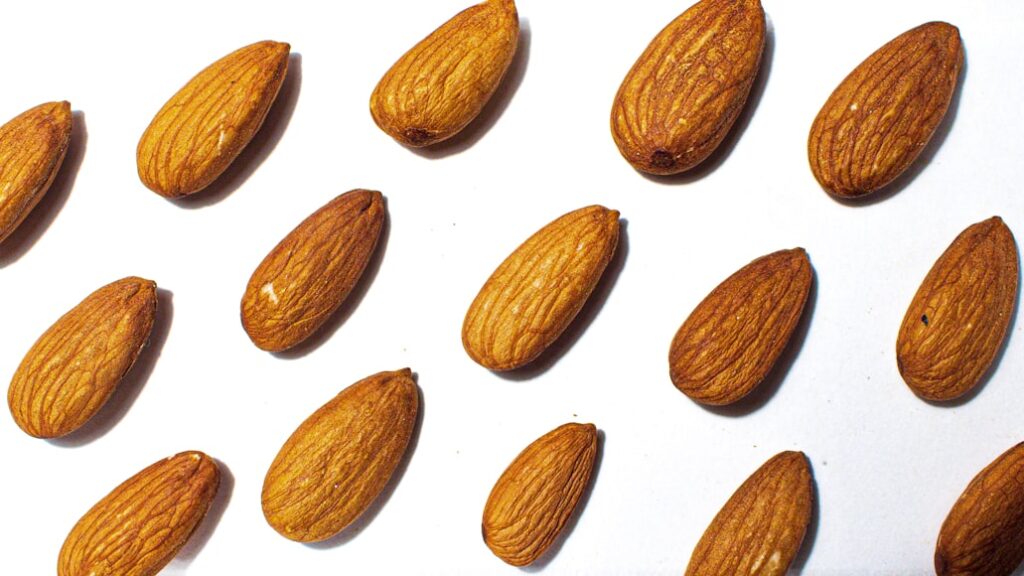I’ve got a little secret for you. That almond you’re about to eat? It’s not really a nut.
Technically, it’s a seed, something called a “drupe.” It’s actually closer to a peach or a cherry than a walnut.
Funny, right? But this small detail says a lot about why almonds are so special.
You already know they’re healthy. They show up in every trail mix and “superfood” list out there. But then you flip the packet and see all that fat and calories. And suddenly, it’s confusing.
Are almonds actually good for you, or are they just sneaky little calorie bombs?
Let’s find out. We’ll look at what science really says about eating almonds: the good, the surprising, and how much you should actually eat to see the benefits.
Contents
- 1 What’s in a Handful? Surprising Almond Nutrition
- 2 A Heart-Healthy Superstar: Almonds for Heart Health
- 3 The Blood Sugar Benefit: Almonds for Blood Sugar Control
- 4 Can They Help with Weight? Almonds for Weight Management
- 5 The Next Frontier: Gut Health and Your Brain
- 6 Almond FAQs: How Much, Raw vs. Roasted, and More
- 7 Easy Ways to Get the Benefits of Eating Almonds
- 8 Your New Daily Habit
What’s in a Handful? Surprising Almond Nutrition

Let’s talk about what’s really in a handful of almonds.
Most studies use one ounce. That’s about 23 or 24 almonds. Basically, a small handful that fits right in your palm. Doesn’t look like much, but it packs quite a punch.
Here’s what that handful gives you:
- Protein: Around 6 grams, more than most nuts.
- Fiber: About 3.5 grams.
- Healthy fats: Roughly 14 grams, mostly the kind that’s good for your heart.
- Vitamin E: Almost half your daily need.
- Magnesium: Enough to help fuel hundreds of processes in your body.
Now, the part that makes everyone pause, calories. The label says around 164 per serving. But here’s the twist: your body doesn’t actually absorb all of them.
A major study back in 2012 found that we only take in about 80% of those calories. So that “164” on the packet? You’re really getting closer to 129.
Why? Because almonds are tough little things. You don’t chew them completely, and their structure keeps some fat locked away. That fat just passes through without being digested.
So here’s our first big takeaway: almonds aren’t nearly as “fattening” as they seem. In fact, they might be one of the smartest snacks you can grab.
A Heart-Healthy Superstar: Almonds for Heart Health

If there’s one thing almonds do better than almost any other food, it’s taking care of your heart.
Study after study has confirmed it. Almonds are great for heart health. But here’s what makes them really impressive: they’re smart about it.
Almonds don’t just lower your cholesterol across the board. They specifically target the bad kind — LDL, the one that clogs your arteries.
At the same time, they help keep your good cholesterol, HDL, right where it should be. That balance is exactly what your heart needs to stay healthy and strong.
And the story doesn’t end there. Almonds are also packed with magnesium, which plays a huge role in keeping your blood pressure in check. When magnesium levels drop, blood pressure tends to rise. Not a great combo for your heart.
There’s more good news. People who eat nuts regularly tend to have lower levels of inflammation throughout the body. Another big win for your cardiovascular system.
One study even found that swapping your usual carb-heavy snack, like a muffin, for about a handful and a half of almonds (around 35 nuts) made a measurable difference in heart health markers.
So, something as simple as switching your snack could actually help your heart work better. Not bad for a tiny “not-a-nut,” right?
Also Read: This Common Habit Is Shrinking Your Brain, No Matter How Much You Exercise!
The Blood Sugar Benefit: Almonds for Blood Sugar Control

Almonds don’t just help your heart; they can help steady your blood sugar, too.
Almonds have a glycemic index that’s practically zero. In simple terms, that means they don’t cause a sudden sugar spike after you eat them. That’s why they’re often recommended for people with type 2 diabetes.
But when you eat almonds with a meal, the healthy fats and fiber slow down digestion, which helps “soften” the blood sugar spike that usually comes from carbs.
And then there’s this clever trick scientists recently tested. It’s called “pre-loading.”
In two studies, people with prediabetes ate about 15 almonds (that’s roughly 20 grams) about half an hour before each meal. Just a small handful before breakfast, lunch, and dinner.
The results were wild. After just three months, nearly a quarter of them (23.3%) completely reversed their prediabetes. Their blood sugar levels went back to normal.
The researchers even called it “the holy grail of medicine.”
So yeah, a few almonds before a meal might just be one of the simplest, most powerful habits you can add to your day.
Can They Help with Weight? Almonds for Weight Management

Here’s the big question everyone asks: how can something that’s high in fat and calories actually help you lose weight?
We already know part of the answer: you don’t absorb all the calories from almonds. But that’s just the start.
Almonds are satisfying. Really satisfying. They’re packed with both protein and fiber: two nutrients that keep you feeling full for longer.
In study after study, people who snack on almonds say they’re less hungry afterward. And when lunchtime or dinner rolls around, they naturally eat less. The calories from the almonds tend to replace other calories, instead of adding extra ones.
So overall, your total intake often stays about the same, or even goes down.
And there’s more good news.
In one study, people swapped their regular high-carb snack (like a muffin) for a handful and a half of almonds. They didn’t just lose weight. They lost belly fat.
Another study compared almond snackers with cookie snackers. Over time, the almond group saw their waistlines shrink, while the cookie group’s waistlines grew.
So yes, almonds really can help with weight management. They keep you full, you don’t absorb all their calories, and they even help flatten your belly.
Not bad for a snack that fits in your palm!
Also see: Just Eat These Every Day Like Japan’s Oldest Doctors – Science Says You Could Live to 100
The Next Frontier: Gut Health and Your Brain

Here’s where almonds get even more interesting. The story actually starts in your gut.
Those brown almond skins you sometimes peel off? They’re full of fiber and plant compounds that your body doesn’t digest, but your gut bacteria love them. Think of almonds as prebiotic food for your microbiome.
When your good bacteria, like Bifidobacterium and Roseburia, feed on those almond fibers, they make something amazing called butyrate. It’s a short-chain fatty acid that acts like fuel for your gut lining. Butyrate helps keep the gut wall strong and reduces inflammation, kind of like patching up tiny cracks before they become leaks.
This gut-friendly effect doesn’t just stop at digestion. Scientists now talk about a “gut-heart axis”, the idea that a healthy gut can actually help lower inflammation throughout your body, which in turn keeps your heart healthier.
And while we’re talking about deeper benefits, let’s move up to the brain.
Almonds are one of the best natural sources of Vitamin E, a powerful antioxidant that protects your cells from damage, including brain cells. Over time, that protection can help slow the effects of aging and support long-term brain health.
Now, to be fair, the research on almonds and memory specifically is still early. So we can’t say they’ll make you sharper or boost your recall overnight. But eating a handful of Vitamin E-rich almonds every day?
That’s a smart move for your brain, and the rest of you, too.
Read: These 6 Foods Will Burn Fat and Heal Your Body, Says a Fasting and Nutrition Expert
Almond FAQs: How Much, Raw vs. Roasted, and More

Let’s tackle the big almond questions, the ones everyone has once they’re ready to make this a daily habit.
How Much Should You Actually Eat?
Research shows the sweet spot is between 1 to 1.5 ounces a day.
That’s about 23 almonds for a standard serving (28 grams), a perfect handful. If you want to go a little higher, 1.5 ounces (around 35 almonds) is what the American Heart Association recommends. It’s also the amount used in many of the studies that showed lower belly fat and improved cholesterol levels.
So, aim for one small handful every day. That’s all you need to see results.
Raw vs. Roasted Almonds?
Good news: both are great. Nutritionally, they’re almost identical.
Roasting can make almonds a bit easier to digest and slightly reduce phytic acid (that “anti-nutrient” you might’ve heard about). Just make sure you pick dry-roasted or raw, unsalted almonds, not the ones fried in oil or loaded with salt.
If you like the crunch, go roasted. If you like them plain and simple, go raw. Either way, you win.
What About Phytic Acid (the “Anti-Nutrient”)?
You may read online that phytic acid in nuts is an “anti-nutrient.” It can bind to minerals like iron and zinc and block their absorption.
This is not a concern for most people in developed countries.
This is only a significant issue in developing nations. There, people’s entire diets may be based only on high-phytate grains and legumes.
If you eat a varied diet, the massive benefits of almonds far outweigh this minor effect. Don’t worry about it.
Do I Get the Same Benefits from Almond Milk or Butter?

Here’s where things get interesting. The form really matters.
Almond milk: Mostly water. A cup of unsweetened almond milk has barely any protein or fiber. It’s a great low-calorie drink, but it doesn’t deliver the same almond benefits.
Almond butter: Much closer to whole almonds nutritionally. But since it’s fully blended, your body absorbs all the fat and calories.
Whole almonds: The gold standard. They keep you full, give you fiber, and you don’t absorb all their calories.
The bottom line:
- Eat whole almonds for satiety, fiber, and almonds for weight management.
- Eat almond butter for a great source of healthy fats and (fully absorbed) calories.
- Drink almond milk as a low-calorie drink.
They’re all good. But if you want the full power of almond nutrition, go with the whole nut (or, well, seed).
Read: I Avoid These 5 Foods & My Body Feels 30 Years Younger, Says a Harvard Genetics Professor
Easy Ways to Get the Benefits of Eating Almonds

Getting your daily handful of almonds isn’t hard, and it doesn’t have to be boring either. Here are some easy ways to make it part of your routine:
- The Pre-Meal Loader
Try eating a small handful, about 20 grams or 15 almonds, about 30 minutes before your main meals. This trick helps steady your blood sugar and keeps those post-meal spikes in check. It’s one of the smartest (and simplest) almond habits you can build.
- The Smart Snack
Keep a small pack of almonds in your bag, desk, or car. Around 1.5 ounces (35 almonds) is perfect. They crush mid-day hunger without crashing your energy levels later. This move is gold if you’re watching your weight or tend to snack mindlessly.
- The Topper
Sprinkle chopped or slivered almonds on your oatmeal, yogurt, smoothie bowl, or salads. You’ll add crunch, flavor, and a ton of nutrients without even noticing the effort.
- The Smoothie Boost
Toss a tablespoon of almond butter into your smoothie. It makes it creamy, satisfying, and loaded with healthy fats and protein.
- The Crust Upgrade
Use crushed almonds instead of breadcrumbs to coat your fish or chicken before baking. It’s crisp, flavorful, and adds a nutritious twist to regular meals.
Almonds fit in almost anywhere: breakfast, lunch, snacks, or dinner. A handful a day is enough to give your heart, blood sugar, and energy levels a real boost.
Your New Daily Habit
So, almonds aren’t just something to munch on.
The science is pretty clear now: eating almonds really does make a difference.
They’re what you’d call a smart fat, the kind that helps lower your bad cholesterol while keeping your good cholesterol strong. That’s huge for your heart.
They also help steady your blood sugar, curb hunger, and even go after stubborn belly fat. Some studies have shown they can help people with prediabetes get their numbers back to normal.
And it doesn’t stop there. Almonds even feed the good bacteria in your gut, which can help lower inflammation throughout your body.
So stop worrying about the calorie count. Just grab a handful, somewhere between 23 and 35 almonds a day, and make it part of your routine.
Your heart, your metabolism, and your waistline will quietly thank you for it.